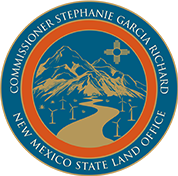SANTA FE, N.M. – New Mexico Commissioner of Public Lands Stephanie Garcia Richard has executed long-term leases for six new community solar projects to be constructed on state lands. Leases for the projects were awarded to the highest bidders at public auctions held at the State Land Office building in Santa Fe. Each project is expected to generate about 5 megawatts of solar energy when operating at full capacity, or 30 megawatts in total. That is enough energy to directly power about 1,000 New Mexico homes per project, or about 6,000 homes in total. Together, the projects will generate $16.2 million for New Mexico’s public schools and other institutions over the lifetime of the leases.
Community solar projects allow more residents to access the benefits of solar energy without incurring the costs of a direct installation on their homes. Commissioner Garcia Richard has made community solar projects a priority because of the direct benefits they provide to New Mexicans, including cleaner electricity and lower utility costs.
The six new community solar projects on state land include:
- 40 acres in Doña Ana County, awarded to US Solar
- 40 acres in Doña Ana County, awarded to Pluma LLC
- 160 acres in Grant County, awarded to Pluma LLC
- 80 acres in Hidalgo County, awarded to Pluma LLC
- 80 acres in Roosevelt County, awarded to SunShare
- 30 acres in Valencia County, awarded to US Solar
“Community solar projects bring clean, affordable energy directly to New Mexico customers. I’m thrilled that state lands can play such an integral role in advancing access to renewable energy across the state,” said Commissioner Garcia Richard. “Many New Mexicans want to use renewable energy to power their homes, but may lack the financial resources to pursue it on their own. Community solar allows more New Mexicans to benefit from clean energy and be a part of the state’s energy transition. We have heard a great response to this program, and will keep holding auctions to make affordable, clean energy to as many New Mexicans as possible.”
In September 2024, Commissioner Garcia Richard approved the first-ever community solar project on state trust lands on 80 acres in Valencia County. Two months later, Commissioner Garcia Richard approved a lease for a community solar project in Doña Ana County. The community solar projects approved on state lands so far are significant because they will provide affordable, clean energy to local residents who otherwise may not be able to access energy from renewable installations on their homes. The projects also help advance the state’s efforts to expand access to renewable energy for consumers statewide following the passage of the Community Solar Act in 2021. The State Land Office is planning to hold 2 more community solar auctions in the coming months.
Commissioner Garcia Richard created the first-ever Office of Renewable Energy within the Commercial Resources Division at the State Land Office with the goal of tripling renewable energy leasing and production on state trust lands. The Office has far exceeded initial expectations, as renewable energy on state lands has increased more than six-fold since its inception. When Commissioner Garcia Richard assumed office, there were 400 megawatts of renewable energy under lease on state lands. After today’s auction, there are now approximately 2,745 megawatts of wind and solar energy under lease. In addition, there are now 51 renewable energy leases at the state land office, up from 12 when Commissioner Garcia Richard took office in 2019.
Click here to view maps of solar and wind projects on state lands.
Commissioner of Public Lands Stephanie Garcia Richard has overseen the New Mexico State Land Office since 2019. In that time the agency has earned more than $11 billion for New Mexico public schools, hospitals, and universities. Over 13 million acres of state trust land are leased for a variety of uses, including ranching and farming, renewable energy, business development, mineral development, and outdoor recreation. The State Land Office has a dual mandate to use state trust land to financially support vital public institutions, while simultaneously working to protect the land for future generations.
